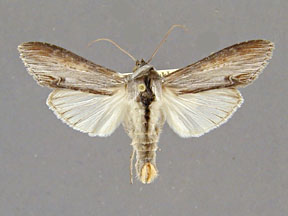
Cucullia asteroides
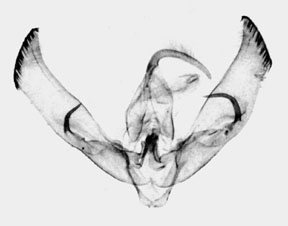
Cucullia charon male genitalia
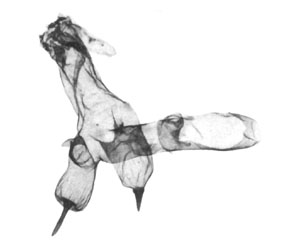
Cucullia charon male aedoeagus
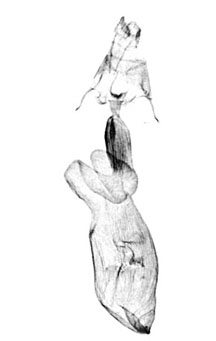
Cucullia charon female genitalia
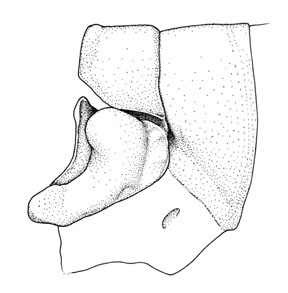
Cucullia external tympanum
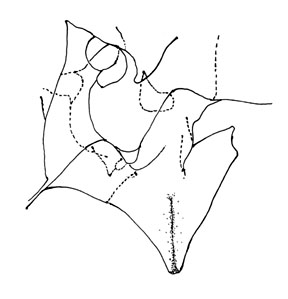
Cucullia internal tympanum
This segment on the Cuculliinae is a modified
and shortened version of the revision of the North American Cuculliinae
found in:
Poole, R.W. 1995. The Moths of America North
of Mexico. Noctuoidea: Noctuidae (Part). Fascicile 26:1.
Checklist
of the Species of the Cuculliinae
|
The subfamily Cuculliinae, as used
here, consists almost entirely of the single genus Cucullia.
A few other genera have been grouped with Cucullia, but not with
much confidence. The sister group of the Cuculliinae may be the Oncocnemidinae,
although I make this statement without much justification. Other possible
sister groups to the Cuculliinae occur outside of North America. One group
is a collection of Palearctic genera without a formal name but including
Metopoceras and Calophasia. A large group of species
and genera in southern South America, primarily in Patagonia, also seems
to bear some relationship with the Cuculliinae and the Oncocnemidinae.
This group of genera includes the genera Desertullia, Neuquenia,
and Metacullia. Unfortunately the generic limits in this Patagonian
group are not well defined at present and most of the species in the group
are incorrectly placed in Palearctic genera. The species of Cucullia
have a distinctive superficial appearance and are readily reconized. Both
the superficial and external features of the genus are discussed under
the generic heading. The formal description of the subfamily is given
below. The subfamily description also serves for the generic description
of Cucullia because only the genus Cucullia is undoubtedly
placed in the subfamily at present. Comments on the larvae and their biologies
are also reserved for discussion under the generic heading.
Head: antenna of male simple, laminate, or serrate, but most commonly
simple; antennal base with tuft of scales; frons smooth or roughened,
sometimes with a conspicuous raised ridge or triangular region above the
clypeus; clypeus usually slightly projecting; pilifer strong, sclerotized;
proboscis well developed; gena trapezoidal, well developed; ocelli present;
eye lashed below antenna and from posterior margin of eye.
Prothoracic leg: tibia usually somewhat shortened, with or without a tibial
claw; tibial spines absent; tarsal spines of all three legs arranged in
three equal rows.
Wing venation: forewing usually elongate; venation distorted by elongation
of forewing; accessory cell present; R1 arising from main radial vein,
R2 arising from two thirds length of accessory cell; R3, R4, and R5 from
apex of accessory cell, R3 and R4 stalked about half way to apex.
Thorax: with long, hair like scales; patagia capable of elevation into
a pointed hood.
External tympanic region: see screen on left; hood not greatly developed
and its edge flush with abdominal sternite 1+2; tergo-pleural groove continued
by a sclerotized invagination of the second abdominal membrane separating
the sternite and tergite.
Internal tympanum: see screen on left; pocket IV large and triangular.
Abdomen: weak tufts on first three or four abdominal segments; male abdomen
with or without basal hair pencils and Stobe's Glands; eighth sternite
with sclerotization u-shaped and with or without a linear, internal setal
patch.
Male genitalia: Valve usually elongate; clasper and basal process of the
sacculus normally present; clasper oriented perpendicular to long axis
of valve; rudimentary digitus present in scattered North American and
Palearctic species; free pleurite present, rounded, articulation with
tegumen simple; penicillus absent; corona usually present on apex of valve
but sometimes reduced or absent; vesica of aedoeagus with one to three
strong spines borne on diverticula, sometimes minutely spined as well
and/or with a strap like sclerotized area near the base of the vesica.
Female genitalia: see screen on left; ovipositor lobes usually unmodified;
ductus bursae of variable length, usually with sclerotized ridges; corpus
bursae apparently absent; ductus seminalis arising from bottom of appendix
bursae.
The Genera
of the Cuculliinae
Cucullia
Dolocucullia
Opsigalea
Emariannia
The Plates
Plate 1
Plate 2
Plate 3
Plate 4
Plate 5
|


